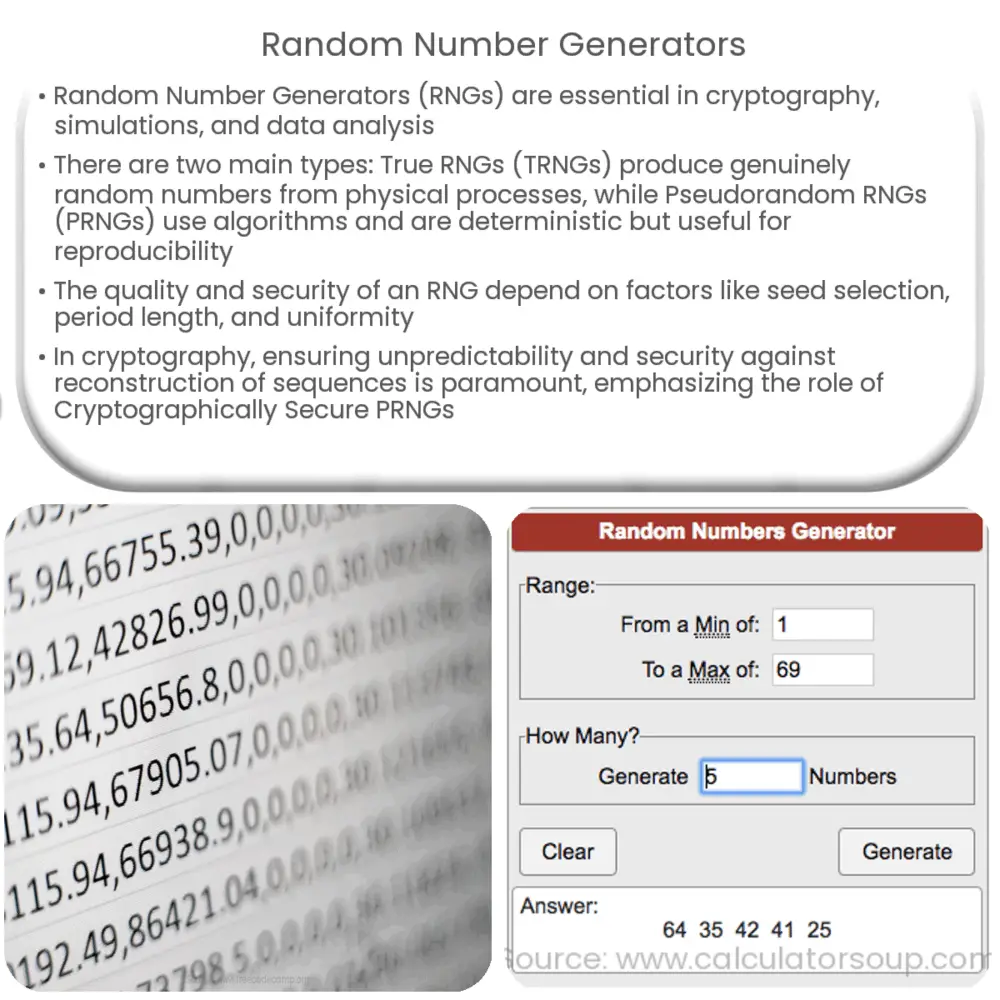Explore the fundamentals of Random Number Generators (RNGs), their types, uses, and security considerations in cryptography and simulations.

Understanding Random Number Generators
Random Number Generators (RNGs) play a crucial role in multiple domains including but not limited to cryptography, computer simulations, and data analysis. But what exactly is a Random Number Generator? Let’s delve into the fundamentals of RNGs to gain a better understanding.
What is a Random Number Generator?
At the most fundamental level, a Random Number Generator (RNG) is a system that generates a sequence of numbers that lack any pattern, i.e., the numbers are apparently random. The ‘randomness’ is a crucial factor as it ensures the unpredictability and fairness in use-cases such as simulations and games.
Types of Random Number Generators
TRNGs generate random numbers from a physical process rather than by means of an algorithm. They leverage phenomena that are fundamentally random, like atmospheric noise or radioactive decay. Due to their nature, TRNGs are also known as hardware random generators. The primary benefit of TRNGs is that the numbers generated are entirely random and independent of each other, which makes them extremely difficult, if not impossible, to predict.
Contrary to TRNGs, PRNGs generate random numbers based on initial seed data and an algorithm. Although the numbers appear random and may pass statistical tests for randomness, they are deterministic in nature. Given the same seed and the same sequence of operations, a PRNG will always produce the same sequence of numbers. While this may seem like a drawback, it is actually useful in circumstances where reproducibility is required, such as in debugging software or running simulations.
Use Cases of Random Number Generators
Random Number Generators have a wide range of applications in diverse fields. Some of the key use-cases include:
Despite their widespread use, it’s essential to choose the appropriate type of RNG for a specific application to ensure effectiveness and security.
Concerns and Considerations in Using Random Number Generators
While RNGs have extensive applications and benefits, their use also raises certain considerations and concerns. The effectiveness and security of an RNG largely depend on its quality. In the context of a PRNG, the quality refers to the unpredictability and pattern dissimilarity of the number sequence it generates. A high-quality PRNG will generate a number sequence that appears random and is hard to predict.
For TRNGs, the main challenge lies in accurately capturing the randomness from the physical process. The presence of any pattern or bias in the data could significantly compromise the generator’s randomness.
Ensuring Adequate Security in Cryptographic Applications
In cryptographic applications, an adversary’s ability to predict the RNG output could lead to disastrous consequences. Therefore, Cryptographically Secure Pseudorandom Number Generators (CSPRNGs) are designed to withstand attacks even from adversaries with considerable computational resources. CSPRNGs must pass two critical tests: next-bit unpredictability and the inability to reconstruct past sequences if the internal state of the generator is compromised.
Conclusion
Random Number Generators are invaluable tools in modern computing, facilitating the functionality of diverse fields from cryptography to computer simulations and data analysis. Understanding their underlying mechanisms, strengths, and limitations is vital for their effective and secure utilization. Despite the complexity and potential issues related to randomness, the development of robust standards and practices continues to enhance the quality and security of RNGs. As our digital world expands, the importance and relevance of these generators only promise to grow, underlining the need for ongoing research and innovation in this field.

